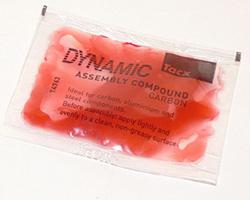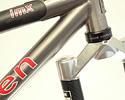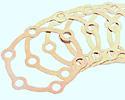
Recently on Cyclingnews.com |
Tech News – October 25, 2006Edited by James Huang Got tech? Send press releases, news, and tech questions to the Cyclingnews tech desk. By James Huang FSA and Tacx offer carbon 'grease'
In some sense, the cycling world is still fumbling through the dark when it comes to the care and feeding of carbon fiber components, particularly in regards to installation. By now, most of us have realised that carbon parts can't generally be clamped as tightly as metal ones, and they simply don't clamp as well overall since their surfaces are often significantly more slippery. Moreover, the material tends to compress a bit when squished. Torque recommendations and appropriate tools are useful in preventing the aforementioned damage, but the lack of surface friction and carbon fiber's relative lack of compressive rigidity still leads some mechanics to overtighten parts in an effort to keep handlebars and seatposts from slipping. FSA and Tacx now offer assembly compounds that could potentially save more than a handful of otherwise-doomed parts. The paste contains a suspension of tiny plastic beads that provide a claimed 30% increase in surface friction when clamped, which also translates into a concurrent reduction in clamping forces to achieve the same result without the compound. This is analogous to sprinkling sand in between parts but the plastic beads aren't abrasive and, thus, won't cause any damage (the beads simply compress under compressive load). In addition, the assembly compounds also provide a measure of safe lubrication for easier movement when parts aren't cinched down. When unloaded, the plastic beads act as tiny ball bearings that can greatly facilitate seatpost adjustments, particularly in frames with tighter fits. Moreover, the paste also prevents water contamination into the seat tube around the post, much as grease is meant to on metal interfaces. Granted, carbon fiber doesn't really corrode per se, but any mechanic worth their salt will quickly remind you that that can't be said about the aluminum frame or sleeve that that post is inserted into (check your carbon frame; oftentimes there's an aluminum sleeve in there). Much as many conventional lubricants will cause a carbon post to swell inside a frame and effectively increase in diameter, corrosion in an unprotected aluminum sleeve will effectively reduce its diameter and create the same, and rather unpleasant, result. The new assembly compound isn't necessarily carbon-specific and can be used on any mating surface where an increase in clamping friction and/or a reduction in clamping force is desired. FSA is now including the new assembly compound with all of its carbon fiber seatposts, and both FSA and Tacx also offer the material separately. More info: www.fullspeedahead.com, www.tacx.com
Cane Creek headsets offer more fork clearance for 29ers
Along with the good inevitably comes some bad. The new 29" mountain bike wheel clearly offers some benefits to many riders but also brings with it some associated problems. One in particular is that of clearance between today's taller and wider suspension fork crowns and controls and the underside of the typical 29er down tube. This problem had mostly come and gone for conventional mountain bikes (save for the 'lucky' few), but the 29er geometry typically produces a much more steeply angled down tube that is more likely to contact the fork crown in a crash. Many newer frame manufacturers, such as Niner and Seven have recently begun offering curved down tubes or altered head tube geometry to offer more clearance, but those solutions are of little consolation for riders with older-style frames that are not so-equipped. Cane Creek now offers an innovative solution in the form of its S-3 Plus 5 headset. Like the standard S-3, the S-3 Plus 5 is equipped with sealed cartridge bearings, alloy cups, and supplemental neoprene seals to keep out crud. The "Plus 5" designation, however, refers to a modified lower cup that provides an additional 5mm of stack height between the head tube and the fork crown. Five millimeters doesn't sound like much, but it could easily provide the critical amount of extra height to provide fork crown clearance in some cases. As expected, the taller lower cup does add a few grams; the standard S-3 headset weighs 124g while the S-3 Plus 5 adds an additional 12g. Retail cost on the S-3 Plus 5 is also a bit higher at US$63 MSRP vs. US$53 for the standard version. More info: www.canecreek.com
Time RXS pedals recalled
Time Sport International recently announced the recall of several of its popular RXS road pedals sold between October 2004 and July 2006 - including the RXS Titan Carbon, RXS Carbon, RXS, and RXE models with either black or grey pedal bodies. The white-bodied RXS World Champion is not subject to the recall, nor is any 2007 model or pedals that have a gold dot on the underside of the body (see Time's official release for images). Affected units may have an inadequately secured bearing cap, which can result in the separation of the pedal body from the spindle during use. Time is advising that consumers cease riding the affected pedals immediately. Dealers and consumers are asked to contact Time Sport International directly to arrange for inspection and/or repair. Repaired pedals will be identified with a red dot on the pedal body just inside where the bearing cap is installed. More info: www.timesportusa.com/rxsrecall Syntace disc rotor shims ease wheel changes
Recent rule changes in both mountain bike and cyclocross racing have increased the prevalence of spare wheels in the pit area equipped with disc brakes. Many of those racers have also realised that, in spite of so-called 'standards', the disc rotor spacing on their panoply of spare wheels can vary a bit. Given the tight clearances on most typical disc brake calipers, it doesn't take much of a shift to create some substantial disc pad rubbing. Rather than iteratively readjust or re-shim their brake calipers with each wheel swap (which, obviously, isn't practical during an event), the more astute riders have rather shimmed their disc rotors so that they all match up, enabling quick and easy wheel swaps with consistent braking performance. Still, fiddling with tiny shims in multiples of six can be headache inducing, and slight variances in the shims themselves can result in a slightly warped rotor - thus repeating the same problem you were hoping to solve. Instead, the clever Germans at Syntace offer a one-piece rotor shim that is designed to serve the same function as the individual ones. Not only are these much more convenient to handle but they are also properly sized for the M5 bolts commonly used to secure the rotors instead of the larger M6 bolts used for brake calipers. Syntace's 0.2mm-thick disc rotor shims are offered in packages of eight at a retail cost of US$10. More info: www.syntace.com |





